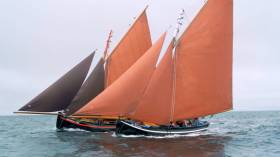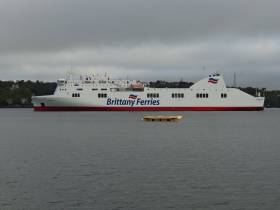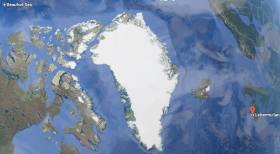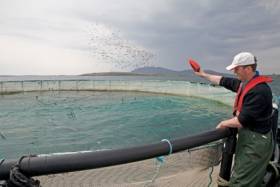Displaying items by tag: Connemara
Conamara Sea Week Parade Tonight at Letterfrack, Galway
Giant “fire sculptures”, a community dinner, jazz lunch and a walk to Omey island are among activities planned for Conamara Sea Week’s programme based in and around the Quaker village of Letterfrack.
Ecologist Gordon D’Arcy is participating in a schools programme, and students from primary to third level have created images for the “After the Light” parade tonight, Wed October 23rd, from 7pm.
The award-winning festival, which has been running since 1984, is focused on the community, with a strong environmental focus.
“Myth, magic and a hint of madness” is promised for the mid-week parade, involving students from five primary schools, local crèches, Youthreach, Galway-Mayo Institute of Technology (GMIT) Letterfrack, the Galway Roscommon Education and Training Board and the Brothers of Charity.
An “active age club” lunch and music at Rosleague Manor takes place on Thursday, October 24th, and that same evening a community dinner in Veldon’s Seafarer will offer food made by award-winning chef Jonathan Keane of the Lodge at Ashford.
Artist Mo West will open a sea week “small works” art exhibition at Connemara National Park on Saturday (Oct 26), and John O’Halloran will lead a walk on Sunday to Omey island, meeting at Claddaghduff church at 10.30am.
The programme, including music of all genres, continues until bank holiday Monday, and further information is available by phoning 085 1154629 or check the website here
Five people were rescued off North Co Antrim yesterday afternoon (Friday 30 August) when their 33ft yacht got into difficulty near Rathlin Island.
Red Bay RNLI’s volunteer crew were requested to launch their all-weather lifeboat 1.20pm following a report that the yacht was struggling to make headway in difficult conditions at sea some five miles south-east of Rathlin.
Two of the crew onboard the yacht — which was on passage to Carrickfergus — were also suffering from seasickness, Red Bay RNLI says.
The lifeboat crew set up a tow and brought the vessel to Ballycastle. Speaking later, Red Bay RNLI press officer Paddy McLaughlin said: “Conditions at sea were challenging this afternoon and the crew made the right decision to call for help.”
Elsewhere, Clifden RNLI in Connemara launched its new all-weather lifeboat for the first time on Thursday afternoon (29 August) to reports of a RIB adrift and in danger in Ballinakill Bay between Letterfrack and Renvyle.
However, it was the D class inshore lifeboat Celia Mary which was first on the scene — where volunteers found two people on a 5.5m RIB with engine failure that was very close to the rocky shore in worsening weather conditions, with a Force 6 wind at the time.
Lifeboat helm Thomas Davis agreed with the two people on board the RIB that the vest course of action was a tow back to shore, which was safely completed.
Davis said: “We were glad to be able to help these people recover their boat today.
“We also wish to remind all water users in Connemara to contact the coastguard or emergency services at the earliest opportunity when things go wrong — we would always rather launch and be stood down than risk other possible outcomes.”
Clifden RNLI Rescue Man Trapped in Shoreline Fall
A man whose leg got trapped on the Connemara shoreline during a rising tide was brought to safety in a multi-agency rescue on Thursday evening writes Lorna Siggins
The incident occurred when a couple were out walking at Slackport on Slyne Head, close to Ballyconneely, according to the RNLI Clifden lifeboat station.
The man fell on the shoreline, trapping his leg badly in some rocks and was unable to free himself. RNLI Clifden station press officer Catherine Pryce says the location was close to the high watermark in a rising spring tide.
The RNLI Clifden lifeboat and Cleggan Coast Guard volunteers, along with the Irish Coast Guard Rescue 118 helicopter from Sligo responded after the couple raised the alarm.
Clifden’s Atlantic 85 inshore lifeboat was launched with Joe Acton at the helm, along with the station’s Mersey class all-weather lifeboat under the command of coxswain James Mullen.
“ The Atlantic 85 was first on the scene and crewman Alan Pryce went ashore to assess the situation and administer first aid. Alan was quickly joined by two more crew members from Clifden’s all-weather boat,” Ms Pryce said.
The man’s injuries were assessed, and he was winched up to safety by the Sligo helicopter crew.
Clifden’s RNLI lifeboat station took delivery of a new all-weather Shannon class lifeboat earlier this week, which will increase the station’s range and capability.
‘This was an urgent and very serious call out and the crew located and assisted the casualty very quickly,” Clifden RNLI operations manager John Brittain said.
“ It has been a very busy week for our station with the arrival of our new Shannon class lifeboat, and the crew once again demonstrated that they are always there to respond when needed, working closely and effectively with our Coast Guard colleagues," Mr Brittain added.
Galway Bay FM reports that An Bord Pleanála has refused planning permission for a development at a Connemara site overseen by Udarás na Gaeltachta.
Plans for the Páirc na Mara facility were previously approved by Galway County Council, but continued to face opposition from local groups concerned that the initial proposals would develop into a full-scale salmon farming facility.
That decision has now been overturned by the national planning authority, according to Galway Bay FM.
Four months ago the Páirc na Mara marine project had welcomed the announcement of €2 million in funding from the Business, Enterprise and Innovation to develop a market-focused marine innovation and development centre at the Cill Chiaráin site.
#OnTV - A new four-part documentary series on the people of Ireland’s west who keep the Galway Hooker sailing tradition alive behind tomorrow night (Thursday 10 January) at 8pm on TG4.
Bádóirí provides an insight into seven Connemara families, part of one of the few indigenous communities of sailors left in Europe, as they compete to be champions of the Galway Hooker Association Racing League.
The first of four episodes screens tomorrow at 8pm and will be available to stream for viewers in Ireland on the TG4 Player.
Connemara Salmon Farm Freshwater Plans To Face High Court Review
#FishFarm - Permission granted for a salmon farm to extract water from a Connemara lake is facing a judicial review, as the Connacht Tribune reports.
An Bord Pleanála recently greenlit plans by Bradán Beo Teo, the region’s biggest producing salmon farm enterrprise, to extract fresh water from Loch an Mhuilinn for cleaning and disease treatment purposes after the company was previously blocked by Galway County Council.
But now local environmental activists are behind a proposed High Court review of the way the planning board arrived at its decision.
The Connacht Tribune has more on the story HERE.
#FerryNews - Brittany Ferries new chartered Connemara has completed a maiden voyage overnight from Cork however instead of arriving in Roscoff, the ropax ferry diverted to Brest from where the ship this afternoon has just berthed, writes Jehan Ashmore.
The 500 passenger /195 car capacity Connemara was originally intended to launch Brittany Ferries much anticipated new first ever Ireland-Spain direct ferry route on 29 April (since revised to this Wednesday, 9 May). As for the debut of Connemara, circumstances dictated otherwise, with the ropax ferry picking up a pilot this afternoon prior to berthing at Brest as a temporary port.
Connemara was scheduled to depart Cork yesterday mid-afternoon but did not vacate the berth at Ringaskiddy until after midnight, today. The long delays encountered in the Irish port were due to a mandatory survey of the Brittany Ferries chartered-in Cypriot flagged ropax. The surveys were carried out by (DTTAS) Department of Transport, Toursism and Sport.
Officials from DTTAS through their division, the Marine Survey Office (MSO) part of Irish Maritime Administration (IMA) carried out a survey inspection of the 186m Connemara. The surveying of the 27,415 gross tonnage ferry was to satisfy national and international legislation in relation to safety of shipping requirements prior to the certification of the 2007 Visentini built ropax.
The reason for Connemara's change of Breton port today was because Roscoff only has a single ro-ro-ramp which since this morning was occupied by the same operator's Armorique. The cruiseferry arrived overnight from Plymouth on schedule and remained in port until a departure this mid-afternoon bound for Cornwall.
According to Brittany Ferries, foot passengers booked on today's Connemara return sailing to Cork have been advised of a bus connection departing Roscoff (17.00) to transfer those to Brest from where the sailing tonight, Tuesday, 8 May departs at 19.00.
As previously alluded, Connemara was originally to have begun service on the new Ireland-Spain route. The 'économie' no-frills Cork-Santander service as previously reported on Afloat was delayed due to technical works forcing Connemara to dry-dock in Santander. The setback saw the original launch date of the first sailing on the new continental connection, from Santander to Cork on April 29 revised to last Sunday of this May Bank Holiday weekend (but this too was cancelled).
Due to Connemara's operational route diagram, the ropax still departed Spain on Sunday (without passengers or freight) to Cork. The Brittany Ferries ship, the first named with an Irish name, made an inaugural arrival to Cork Harbour yesterday morning. At 08.00 Afloat monitored the Connemara pass the backdrop of Cobh before berthing in Ringaskiddy Ferry Terminal.
The terminal is also where flagship, Pont-Aven routinely operates cruiseferry based Cork-Roscoff sailings. Cruiseferry sailings are from Cork every Saturday, returning from France on Friday's. Connemara's introduction but also based on the 'économie' service will boost capacity on the Ireland-France route. When sailings settle in, they will operate from Cork every Monday and from Roscoff on Tuesday's.
As mentioned the new Ireland-Spain service begins with a Cork-Santander sailing scheduled from the Irish port tomorrow morning at 11.00. This continental connection to Cantabria, in northern Spain, offers two overnight sailings each week with departures from Cork on a Wednesday and Friday and departures from Santander on a Thursday and Sunday.
Among passengers booked on tomorrow's maiden Ireland-Spain sailing are fans of Leinster Rugby. The province having reached the final of the European Champions Cup play French team Racing 92 from Paris.
Irish fans after disembarking in Santander will head east to the next major sea port city of Bilbao, Biscay, where the San Mamés Stadium is the venue for the sporting finale taking place this Saturday, 12 May.
On another Irish-Iberian connection, if our entry for the Eurovision Song Contest succeeds in tonight's semi-finals, we could also be cheering on at the final of the Eurovision Song Contest. This takes place also on Saturday but in neighbouring, Portugal at the Altice Arena in the capital Lisbon.
Council Seeks More Details On Connemara ‘Marine Innovation Park’ Proposals
#PáircNaMara - Galway County Council is seeking further details on the Páirc na Mara development for Connemara, following an objection from a local group opposed to salmon farming.
New plans for the ‘marine innovation park’ were submitted late last year by Údáras na Gaeltachta, envisaging a low-carbon marine industry hub over nine hectares, and with a focus on aquaculture research.
But as Galway Bay FM reports, an objection by Galway Bay Against Salmon Cages — which has long campaigned against aquaculture projects in the region — has “caused anger in west Connemara” where the park is slated to be developed.
The situation has now prompted the council to seek more information on the fish farming aspects of the project.
Galway Bay FM has more on the story HERE.
Connemara Sea Scouts Solve Mystery Of Marine Research Buoy
#ArcticBuoy - A marine research buoy found on the Connemara coast by local Sea Scouts recently had drifted over 6,000 kilometres across the Beaufort Sea, Arctic Ocean and Atlantic to Ireland.
The buoy, around half a metre in diameter, was found at Lettermullen by the scout troop during an exploration of their local beach.
Michael Loftus, leader of Gasógaí Mara na Gaeltachta (Connemara Sea Scouts), said they often find flotsam and jetsam washed up on the shore, which they can usually identify.
“However, little did we know that this new find would uncover a world of discovery relating to the buoy being launched from an aircraft in the Arctic Ocean and travelling thousands of kilometres to land on the west coast of Ireland.”
The Marine Institute, which works on a series of projects where autonomous instruments are deployed into the ocean for marine research, was contacted to help solve the mystery of where the red buoy came from.
“Although the buoy is not an Argo float that is typically used by the institute as part of the national Argo float programme, we were delighted to help the Sea Scouts establish that the buoy is in fact an Airborne Expendable Ice Buoy, which came from as far away as the Beaufort Sea,” said Diarmuid Ó Conchubhair of the Marine Institute.
The International Arctic Buoy Programme involves a number of different countries including Canada, China, France, Germany, Japan, Norway, Russia, and the United States.
The programme maintains a network of drifting buoys in the Arctic Ocean that are used to monitor sea surface temperatures, ice concentration, and sea level and support weather forecasting. The buoys are also used for validating climate or earth system models which inform the Intergovernmental Panel on Climate Change (IPCC) reports.
Each buoy in this programme has an identification number that is used to track its location in the Arctic Ocean using a type of satellite communication system.
“Using the number marked on this buoy [#4800512], we were able to establish that this particular buoy had been deployed by an aircraft over five years ago in the Beaufort Sea, north of the Yukon and Alaska, west of Canadian Arctic islands,” said Ó Conchubhair.
Dr Eleanor O’Rourke, oceanographic services manager at the Marine Institute, explained: “Researchers involved in the International Arctic Buoy Programme decide where to deploy buoys, particularly where the status of sea-ice may be changing.
“Most of the buoys are placed on sea ice, but some are placed in open water in some of the most remote parts of the world's ocean, where it is difficult for research vessels to access.”
Airborne Expendable Ice Buoys have an average lifespan of 18 months and around 25 to 40 buoys operate at any given time.
“The buoy last reported its data in 2014 and it is likely that it ran out of battery power and spent the last three to four years at the sea surface travelling via wind and ocean surface currents,” said O’Rourke.
In 2007, Ireland became a member of the international Argo programme, which uses robotic instruments known as autonomous Argo floats that report on subsurface ocean water properties such as temperature and salinity via satellite transmission to data centres.
Using a fleet of around 4,000 autonomous floats around the world, the Argo array is an indispensable component of the Global Ocean Observing System (GOOS).
“Similar to the buoys used by the International Arctic Buoy Programme, Argo floats collect and distribute real time information on the temperature and salinity of the ocean,” said Ó Conchubhair, who is vice chair of the European Argo Programme.
“Argo floats; however, measure these variables from the upper 2,000m of the ocean and help to describe long-term trends in ocean parameters such as their physical and thermodynamic state.”
This information is required to understand and monitor the role of the ocean in the Earth's climate system, in particular the heat and water balance.
Click here for more information about Ireland’s involvement in the Argo programme. You can also track and look at data from Irish Argo floats at Ireland’s Digital Ocean.
Four years ago, another Arctic device was found on the North West Coast and exhibited by Transition Year students in Co Mayo, as previously reported on Afloat.ie.
Connemara ‘Marine Innovation Park’ Preps New Planning Application
#MarineScience - A new planning application is set to be submitted for the proposed ‘marine innovation park’ in Connemara, as Galway Bay FM reports.
Páirc na Mara is envisaged as a low-carbon marine industry hub over nine hectares, with a focus on aquaculture research.
As previously reported on Afloat.ie, the new research cluster would form part of a network including the existing Marine Institute facilities at Newport in Co Mayo.
The deadline for expressions of interest in the revised project is tomorrow, Friday 1 December.
Galway Bay FM has more on the story HERE.







































































